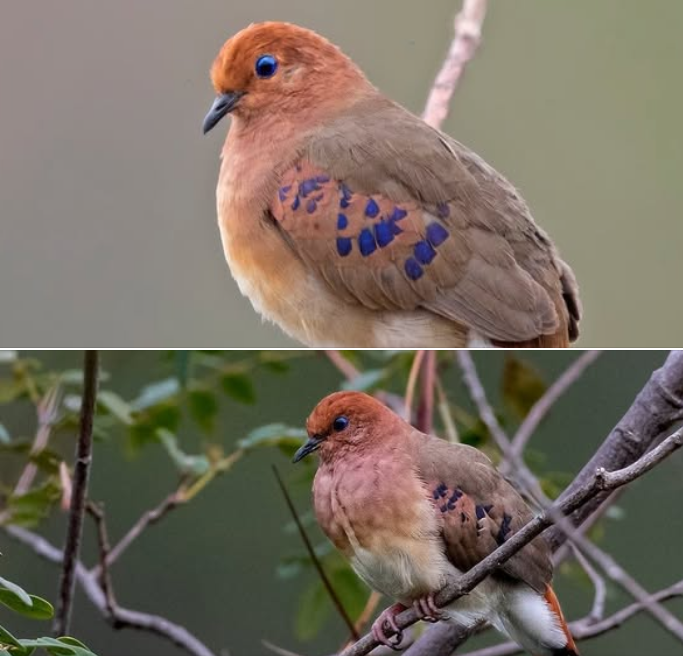UK Zoo Plays Key Role in Hatching Three of the World’s Rarest Birds: The Blue-Eyed Ground Dove
In a significant milestone for global bird conservation, three chicks belonging to one of the world’s rarest bird species—the blue-eyed ground dove—have successfully hatched in Brazil, thanks in part to the expertise of a UK zoo. With only 11 individuals believed to survive in the wild, this breakthrough brings a fresh wave of hope for a species once thought to be lost forever.
The hatching occurred in the Brazilian state of Minas Gerais, the only known home of Columbina cyanopis, or the blue-eyed ground dove. The successful rearing of these chicks represents a massive step forward in creating a viable insurance population to protect the species from extinction.
From Myth to Miracle
For more than 70 years, the blue-eyed ground dove was considered by many scientists to be extinct. With no confirmed sightings for decades, it became something of an enigma—spoken of in birdwatching circles like a ghost species. That all changed in 2015 when it was rediscovered in a remote region of the Cerrado biome, Brazil’s vast and underappreciated savanna ecosystem.
Its reappearance sparked an urgent international collaboration, bringing together organizations from Brazil, the United Kingdom, and the United States, determined to prevent the bird from vanishing again—this time for good.

Chester Zoo’s Vital Contribution
At the forefront of this effort was Chester Zoo, located in northwest England, which has become renowned for its active role in global wildlife conservation. Andrew Owen, the zoo’s head of birds, and Victoria Kaldis, lead bird keeper, traveled to Brazil to offer hands-on assistance and technical support during the delicate incubation and hand-rearing process.
“It’s a real privilege for Chester Zoo to contribute to safeguarding a species as critically endangered as the blue-eyed ground dove,” said Owen. “Without these coordinated efforts, it’s very possible that this species would disappear within our lifetime.”
Kaldis added, “Hand-rearing chicks of such a sensitive species is a demanding and emotional task. You’re not just raising birds—you’re preserving an entire species’ future.”
The chicks were successfully hatched and raised at Parque das Aves, a leading Brazilian conservation center, under a specialized program led by SAVE Brasil, with logistical and scientific support from American institutions including the Bronx Zoo and Toledo Zoo.
A Race Against Extinction
The goal of the program is not only to increase the number of individuals under human care but also to eventually reintroduce captive-bred birds into protected areas of their natural habitat. Currently, just six blue-eyed ground doves live in managed care—three of which are the newly hatched chicks. Each individual is precious, representing a fragile genetic lifeline.
“This species is critically endangered and extremely rare,” explained Paloma Bosso, technical director at Parque das Aves. “Every chick that hatches is a symbol of hope and an opportunity to reverse what once seemed irreversible.”
All six birds are now under 24-hour monitoring, with detailed data being collected on their health, behavior, and diet. Conservationists have developed a carefully coordinated reproductive strategy designed to avoid inbreeding and maximize the birds’ long-term survival.

The Threats: Why the Blue-Eyed Dove Vanished
The species once enjoyed a broader distribution across the Cerrado biome, an area rich in biodiversity but under constant pressure from agricultural expansion, cattle grazing, and monoculture plantations. As native vegetation was cleared, the dove’s habitat vanished.
The bird’s dramatic decline was so steep and so fast that by the early 2000s, scientists had given up hope. But the rediscovery in 2015 reinvigorated efforts to conserve the species and the ecosystem it calls home.
“This bird is an ambassador for the Cerrado,” said Ben Phalan, head of conservation at Parque das Aves. “Saving it means protecting a web of life that includes plants, insects, and countless other species dependent on this unique biome.”
A Model for Global Conservation
The collaborative nature of the project is being hailed as a model for international conservation, combining field biology, zoo-based expertise, local knowledge, and institutional funding.
As other species around the world face similar threats from habitat loss and climate change, the story of the blue-eyed ground dove serves as a reminder that extinction is not inevitable—and that determined global partnerships can make a life-or-death difference.
Looking ahead, conservationists hope the success of these hatchlings will lead to more births in coming years and eventually to the reintroduction of the species back into its native wild habitats.
“Every song these birds sing is a victory,” said Phalan. “And every new life hatched is a reason to keep fighting for the Cerrado and its extraordinary wildlife.”





